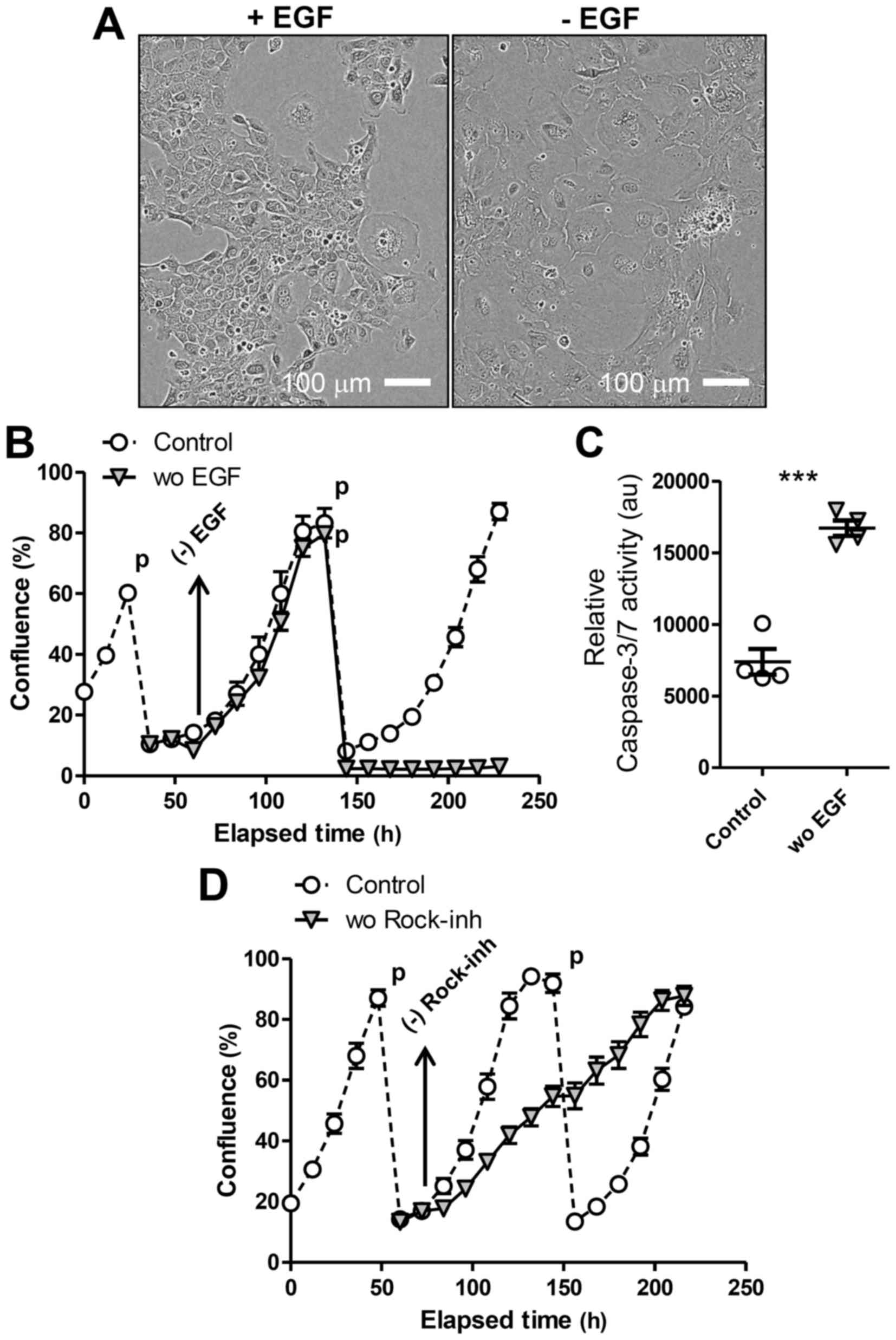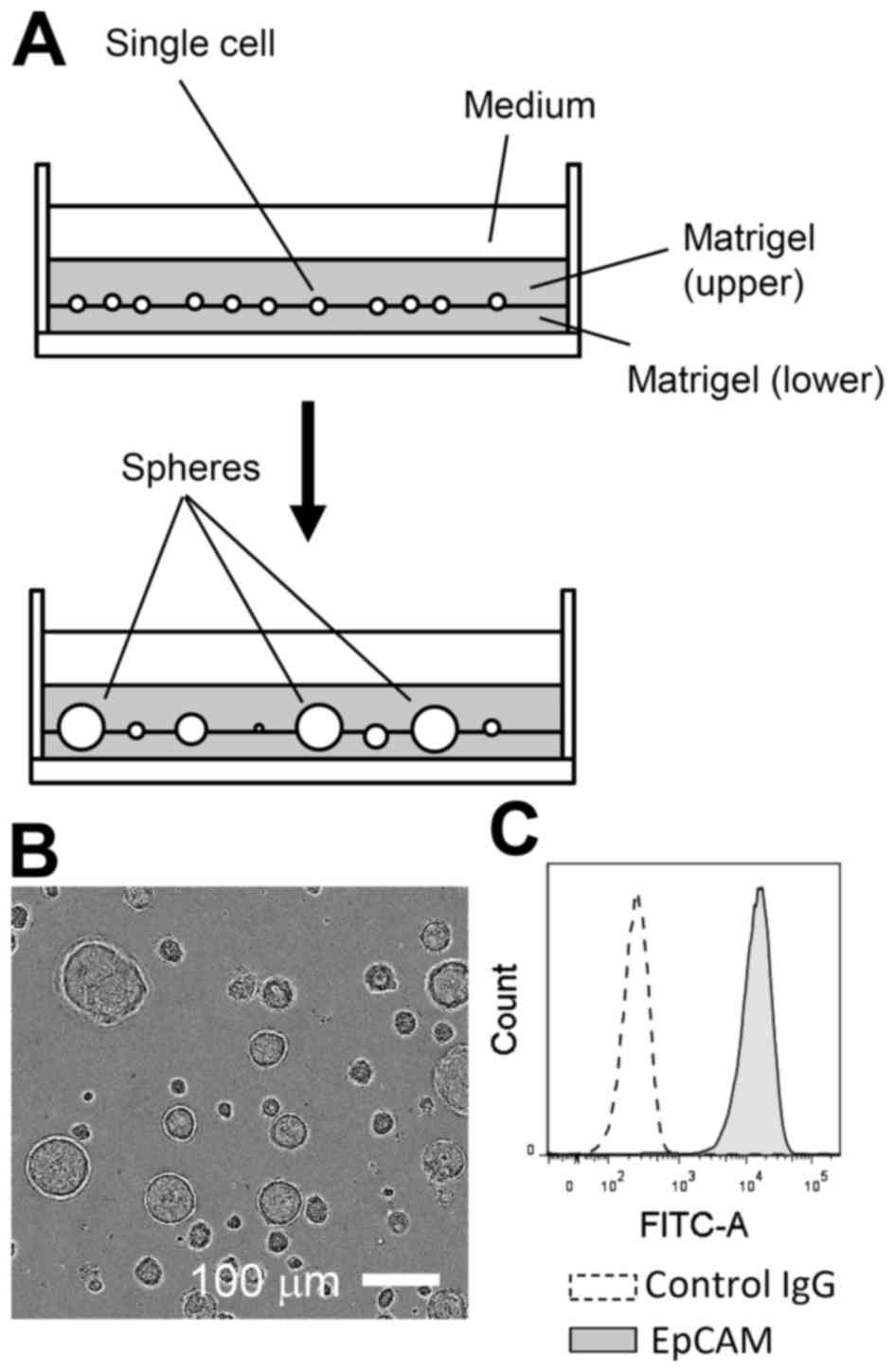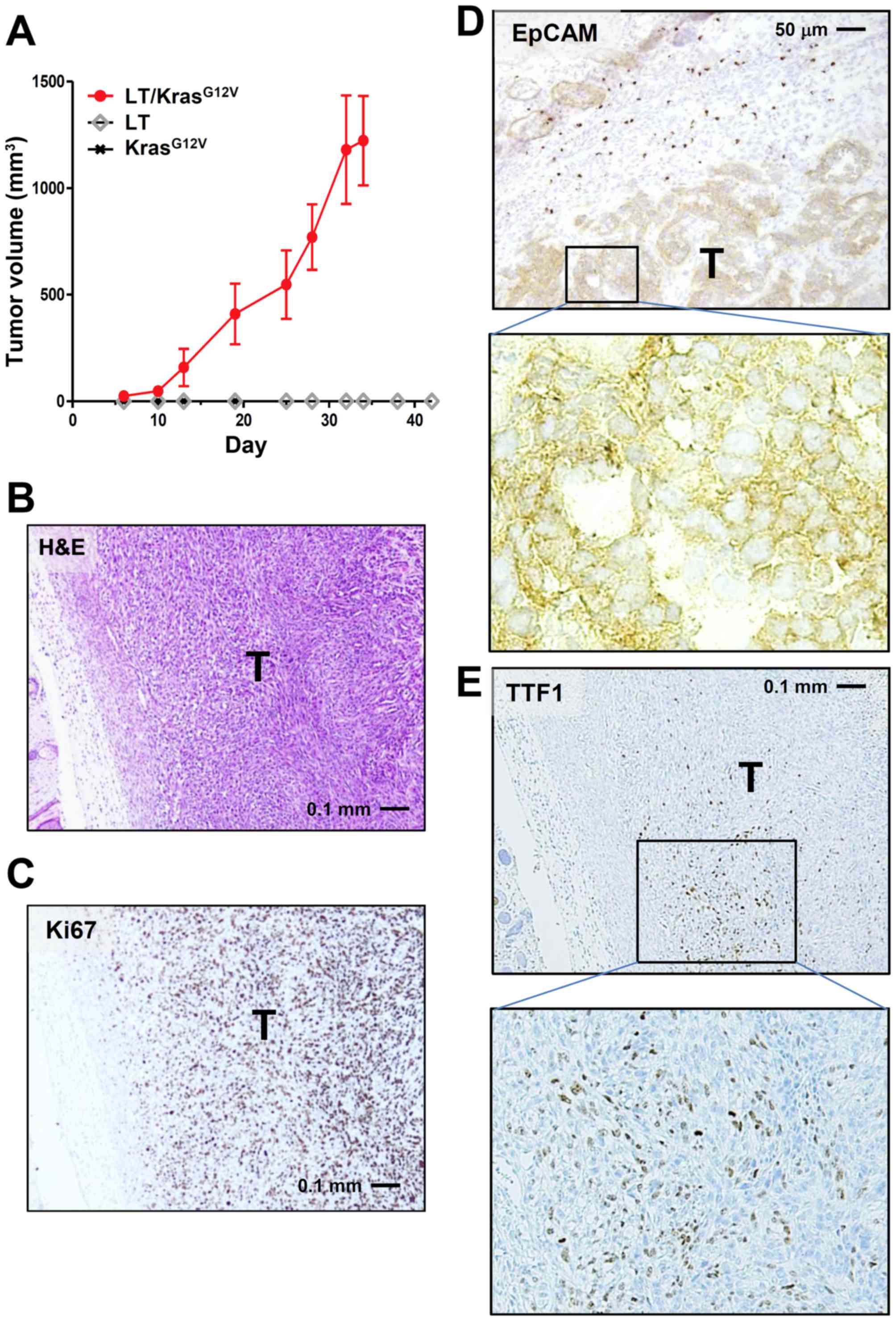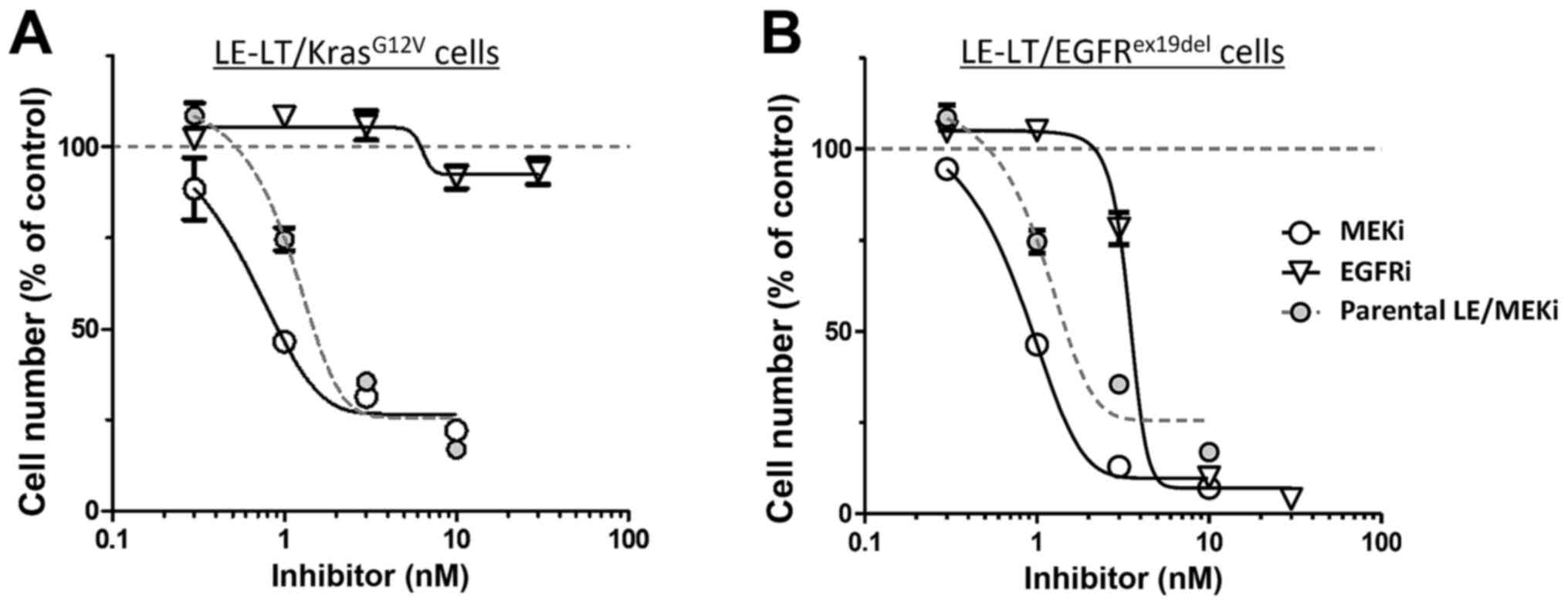Ex vivo model of non‑small cell lung cancer using mouse lung epithelial cells
- Authors:
- Published online on: September 28, 2017 https://doi.org/10.3892/ol.2017.7098
- Pages: 6863-6868
Abstract
Introduction
Lung cancer is the most common cause of cancer mortality in the world, with non-small cell lung cancer (NSCLC) its most prevalent form (1). Despite recent development of oncogene-targeting therapy and immunotherapy, the prognosis for NSCLC at advanced stages remains poor (2,3). Either chemically-induced or genetically-engineered mouse models, as well as patient-derived xenograft models, have provided preclinical models to understand NSCLC and to test novel therapeutic approaches (4). Nonetheless, more efficient methods to culture, expand and transform lung epithelial (LE) cells are required.
The linings of organs are constructed from epithelial tissues, which are the origin of most of solid malignancies. Epithelial cells are connected to each other and/or with the basement membrane, and these cell-cell or cell-matrix interactions cannot be completely recapitulated in 2D culture, rendering analysis difficult using non-transformed epithelial cells in vitro and ex vivo. But recent advances in three-dimensional (3D) culture techniques have enabled in vitro expansion, genetic or environmental manipulation and real-time observations of epithelial cells from numerous human and rodent organs (5,6).
In this study, we applied a 3D culture technique to isolate epithelial cells from a mixed population of mouse lung cells. Almost all isolated cells were positive for EpCAM, an epithelial surface-marker. LE cells could be passaged and expanded for several months and were easily transformed by genetic manipulation.
Materials and methods
Materials
Human EGFR cDNA encoding the exon 19-deletion mutant (EGFRex19del) was generated by a polymerase chain reaction-based method (7) and subcloned into a retroviral vector, pMXs-Puro-3×HA, as described previously (7). The plasmid pBabe-puro Kras-V12 was a gift from Dr C. Counter (8). The plasmid pBabe-neo largeT cDNA was a gift from Dr R. Weinberg (9). Matrigel was obtained from BD Biosciences (Franklin Lakes, NJ, USA). Murine EGF (mEGF) was purchased from PeproTech Inc. (Rocky Hill, NJ, USA). Erlotinib was purchased from Wako Pure Chemical Industries (Osaka, Japan). Trametinib and Captisol were purchased from ChemScene (Monmouth Junction, NJ, USA). Y-27632 was purchased from Calbiochem (Darmstadt, Germany). TrypLE Express from Thermo Fisher Scientific Inc. (Waltham, MA, USA).
Isolation and 3D culture of mouse LE cells
C57BL/6 mice were used at 6–9 weeks of age. Isolation, 3D culture and passage were performed similarly to methods previously described for colon epithelial cells, except that R-Spondin, Noggin and Jagged-1 were not added to culture media (10). In various analyses, mEGF and Y-27632 were added to the medium both in 3D and 2D culture, both at final concentrations of 50 nM. To passage cells in 2D culture, cells were washed with PBS, treated with Trypl Express reagent, which is a mixture of protease and collagenase, and then detached from the dish using a cell-scraper. Time-lapse imaging was performed using an Incucyte cell-analyzer (Essen Bioscience, Ann Arbor, MI, USA).
Caspase activity assay
Cellular caspase activity was measured using the Caspase-Glo 3/7 Assay kit according to the manufacturer's recommendation (Promega, Madison, WI, USA). The values were normalized to cell numbers. The results shown in Fig. 2C is results from analyses of cells 2 h after the re-plating upon passage.
Infection of LE cells with retrovirus
LE cells were transduced with retroviral vectors harboring KrasG12V, EGFRex19del, or SV40 Large-T plus selection marker (Puror for KrasG12V and EGFRex19del, and Neor for SV40 Large-T construct). Ecotropic viruses were packaged using PLAT-E cells (a gift from Dr T. Kitamura, Tokyo University) (11) and Fugene 6 transfection reagent. Infection of LE cells in 3D culture with retroviruses was performed as described (12).
Animal experiments
All animal experiments were performed after approval of Miyagi Cancer Center Research Institute Animal Care and Use committee. In allograft experiments, 4×105 of LE-LT/KrasG12V cells were injected sc into the dorsal flank of nude mice. LE-LT/EGFRex19del cells were injected as 1:1 mixtures with Matrigel at 2×106 cells per injection site.
Immunostaining analyses and flow cytometry
Immunohistochemical analyses were performed using reagents from Roche Ventana systems (Basel, Switzerland). Antibodies against thyroid transcription factor 1 (TTF1) (SP141) and Ki-67 (30–9) were from Roche. Anti-cytokeratin 14 (CK14) goat antibody was purchased from Santa Cruz Biotechnology (Dallas, TX, USA). Anti-prosurfactant protein-C (SPC) antibody (ab40879) was obtained from Abcam (Cambridge, UK). Anti-EpCAM monoclonal antibody (2–17-F-1) was obtained from MBL (Nagoya, Japan). Frozen sections were prepared for anti-EpCAM staining only, as the antibody did not work on paraffin-embedded sections (data not shown). Flow cytometry was performed with a FACS Canto-II flow cytometer (BD Bioscences Inc.).
Statistics
We used Student's t-test (2-tailed) to compare two groups. A P-value of <0.05 was considered significant. Data are presented as means with the SD (Fig. 2B and D) or SEM (all others).
Results
Isolation and characterization of primary LE cells
Primary LE cells were isolated from adult mice and expanded in Matrigel-assisted 3D culture for 2 to 3 weeks in the presence of EGF (Fig. 1A and B). During this period, non-epithelial cells, such as fibroblasts, were likely lost or selected against, as nearly all expanded cells were positive for EpCAM, an established marker of the epithelial lineage (Fig. 1C) (13). In 3D culture, LE cells could be propagated, for at least two to three months, with passage once weekly at an approximately 1:4 dilution.
To test EGF-dependence of LE cells, we transferred cells to 2D culture, as Matrigel used for 3D culture contains substantial amounts of EGF (14). Then, we prepared single-cell suspensions from LE spheres formed in 3D culture and seeded them in tissue-culture plates in the presence of EGF and the Rock-inhibitor Y-27632. Cells adapted to 2D culture (Fig. 2A) and were passaged (1:5 dilution) several times, always replacing EGF and Y-27632 in the media (‘Control’ in Fig. 2B and C). We confirmed that LE cells passaged in 2D were still EpCAM-positive. In addition, the 2D-cultured cells as monolayer were converted into 3D-spheres again when re-transferred on Matrigel. To evaluate the requirement for either of these factors, we prepared replicates of culture when cells were passaged and then withdrew EGF or Y-27632 from the media the next day. Upon removing EGF, LE cells in 2D culture ceased proliferating and became more flattened and enlarged (Fig. 2A), exhibiting the morphology of senescent cells, and died after the next passage (Fig. 2B). Upon the passage, the LE cells deprived of EGF showed markedly higher activity of caspase, suggesting apoptosis induction, compared to control cells (Fig. 2C). We also observed that the presence of both EGF and the Rock-inhibitor was required for maximal LE cell proliferation in 2D culture (Fig. 2D), as Y-27632 withdrawal immediately decreased cell proliferation. These results overall indicate that LE cells expanded in 3D culture over a long period maintain their requirement for EGF to proliferate.
LE cell transformation requires both oncogene activation and tumor-suppressor loss
We next transformed LE cells by transduction with SV40 Large-T and the active Kras-mutant KrasG12V, either singly or together, using retroviral vectors harboring Neor and Puror, respectively, as selection marker. Transduced cells were then drug-selected and nude mice were inoculated with drug-resistant cells. Only LE cells receiving both Large-T and KrasG12V (LE-LT/KrasG12V cells) formed allograft tumors, while cells harboring either Large-T or KrasG12V alone did not (Fig. 3A and B). These results are consistent with previous observations that cellular transformation requires both oncogene activation and inactivation of tumor suppressors such as p53 and pRb (15).
Immunostaining of LE-LT/KrasG12V tumor showed that the Ki-67 index of the tumor was very high (~85%; Fig. 3C) and that tumor cells arising from LE cells were mostly EpCAM-positive (Fig. 3D). In addition, a part of tumor cells were positive for TTF1, an established marker of pulmonary adenocarcinoma (Fig. 3E). No staining in tumors was observed for SP-C and CK14, respective markers of lung adenocarcinoma and squamous-cell carcinoma (data not shown). Together with H&E analysis (Fig. 3B), these results suggest that tumors derived from LE-LT/KrasG12V cells are largely anaplastic (expressing neither adenocarcinoma marker nor squamous-cell carcinoma marker) and that a subpopulation of tumor cells tends to differentiate into adenocarcinoma.
In addition to KrasG12V, we also transformed LE cells with EGFRex19del, the constitutively active mutant of EGFR, in combination with Large-T. Like the LE-LT/KrasG12V cells, the LE-LT/EGFRex19del cells formed tumors when transplanted into nude mice (data not shown).
Oncogene addiction of transformed LE cells
It is well known that tumorigenicity due to KrasG12V activity requires activation of the classical mitogen-activated protein kinase (MAPK) cascade, in which MAPK/ERK kinase (MEK) phosphorylates and activates extracellular regulated kinase (Erk) (16). Proliferation of LE-LT/KrasG12V cells in vitro was independent of exogenous EGF (data not shown), which activates the MEK-ERK pathway. We then tested the sensitivity of LE-LT/KrasG12V cells in vitro to trametinib, a MEK1-inhibitor. As shown in Fig. 4A, proliferation of LE-LT/KrasG12V cells markedly decreased following trametinib treatment, whereas comparable treatment with erlotinib, which potently inhibits EGFR kinase activity, had no effect. In contrast, both trametinib and erlotinib treatment inhibited LE-LT/EGFRex19del cell proliferation (Fig. 4B). These results are consistent with the idea that Kras activates MAPK signaling downstream of EGFR, making cells resistant to EGFR inhibition and that transformation by EGFRex19del requires its kinase activity and downstream MAPK signaling (17). Overall, these results show that transformed LE cells are addicted to oncogenic Kras- or EGFR-stimulated signaling.
Discussion
Use of 3D-culture has become a powerful tool for development of tissue engineering methods for regenerative medicine and to understand cancer biology (6,18). Relevant to the latter, in colorectal cancer research, use of 3D culture has revealed the identity of cancer cells of origin, the function of Yap-dependent regenerative signaling in cancer initiation, and how niche factor requirements are lost during colon cancer progression (19,20). Given the utility of 3D culture in expanding normal epithelial cells, we used this method here to isolate, expand, and transform mouse LE cells.
While our method could be applied to numerous experimental settings, one of particular interest is analysis of cells from genetically-engineered mice in several ways. For example, although several sophisticated mouse models of NSCLC have been established in the last decade (4), it is time-consuming to obtain mice carrying the multiple mutant alleles required for analyses, often requiring a year or more. Our method yields either transformed LE cells or NSCLC-like allograft tumors normally within 2 or 3 months, respectively.
Pharmacological experiments using MEK and/or EGFR inhibitors show that proliferation of transformed LE cells is highly dependent on signaling by the transduced oncogene. Thus, our system could be useful to identify novel chemo-preventatives and therapeutics and to test their efficacy in vitro or in transplantation models. Also, allograft models using syngeneic strains will enable experiments in immune-competent mice, providing a unique opportunity to explore novel immunotherapy approaches and pre-clinical models for testing their efficacy (21).
Tumors arising from transformed mouse LE cells are largely anaplastic. It may be possible to create more differentiated tumors using different combination(s) of oncogenes and tumor-suppressor inhibitions. Alternatively, more differentiated tumors may be achieved using environmental cues, as it is well known that specific culture conditions are critical to promote induction of specific lineages from stem cells (22). To date, several cell types found in the pulmonary system, such as alveolar type 2 cells, club cells, and tracheobronchial basal cells, have been reported as NSCLC cells of origin (13,23). Accordingly, detailed characterization such as comprehensive marker and transcriptome analyses are needed to accurately define identities of LE cells cultured long-term.
In summary, we established an ex vivo method to recapitulate tumorigenesis of mouse LE cells. Our experimental system provides a unique opportunity to study lung tumorigenesis and to develop novel therapeutics against NSCLC. Characterization of long-term expanded LE cells also has implications for regenerative approaches to lung disease, such as chronic obstructive pulmonary disease (24).
Acknowledgements
We would like to acknowledge Dr C. Counter and Dr R. Weinberg for providing plasmid constructs. Thanks are also due to members of the Pathology facility of Miyagi Cancer Center Hospital for technical help in tissue analyses, and to Y. Chiba for secretarial assistance. The present study was supported by grants from JSPS KAKENHI grants (16K14621) to N. T., 26430130 to H. S., 16K07187 to S. I., 15K14387 to I. S., and 16K10486 to K. M.), and to the Takeda Foundation (N. T.), the Mochida Memorial Foundation for Medical and Pharmaceutical Research (N. T.), the Kato Memorial Bioscience Foundation (N. T.), the Uehara Memorial Foundation (N. T.) and the Sagawa Foundation for Promotion of Cancer Research (N. T.).
References
|
Chen Z, Fillmore CM, Hammerman PS, Kim CF and Wong KK: Non-small-cell lung cancers: A heterogeneous set of diseases. Nat Rev Cancer. 14:535–546. 2014. View Article : Google Scholar : PubMed/NCBI | |
|
Sundar R, Cho BC, Brahmer JR and Soo RA: Nivolumab in NSCLC: Latest evidence and clinical potential. Ther Adv Med Oncol. 7:85–96. 2015. View Article : Google Scholar : PubMed/NCBI | |
|
Maemondo M, Inoue A, Kobayashi K, Sugawara S, Oizumi S, Isobe H, Gemma A, Harada M, Yoshizawa H, Kinoshita I, et al: Gefitinib or chemotherapy for non-small-cell lung cancer with mutated EGFR. N Engl J Med. 362:2380–2388. 2010. View Article : Google Scholar : PubMed/NCBI | |
|
DuPage M, Dooley AL and Jacks T: Conditional mouse lung cancer models using adenoviral or lentiviral delivery of Cre recombinase. Nat Protoc. 4:1064–1072. 2009. View Article : Google Scholar : PubMed/NCBI | |
|
Shamir ER and Ewald AJ: Three-dimensional organotypic culture: Experimental models of mammalian biology and disease. Nat Rev Mol Cell Biol. 15:647–664. 2014. View Article : Google Scholar : PubMed/NCBI | |
|
Clevers H: Modeling development and disease with organoids. Cell. 165:1586–1597. 2016. View Article : Google Scholar : PubMed/NCBI | |
|
Watanuki Z, Kosai H, Osanai N, Ogama N, Mochizuki M, Tamai K, Yamaguchi K, Satoh K, Fukuhara T, Maemondo M, et al: Synergistic cytotoxicity of afatinib and cetuximab against EGFR T790M involves Rab11-dependent EGFR recycling. Biochem Biophys Res Commun. 455:269–276. 2014. View Article : Google Scholar : PubMed/NCBI | |
|
Lampson BL, Pershing NL, Prinz JA, Lacsina JR, Marzluff WF, Nicchitta CV, MacAlpine DM and Counter CM: Rare codons regulate KRas oncogenesis. Curr Biol. 23:70–75. 2013. View Article : Google Scholar : PubMed/NCBI | |
|
Hahn WC, Dessain SK, Brooks MW, King JE, Elenbaas B, Sabatini DM, DeCaprio JA and Weinberg RA: Enumeration of the simian virus 40 early region elements necessary for human cell transformation. Mol Cell Biol. 22:2111–2123. 2002. View Article : Google Scholar : PubMed/NCBI | |
|
Onuma K, Ochiai M, Orihashi K, Takahashi M, Imai T, Nakagama H and Hippo Y: Genetic reconstitution of tumorigenesis in primary intestinal cells. Proc Natl Acad Sci USA. 110:pp. 11127–11132. 2013, View Article : Google Scholar : PubMed/NCBI | |
|
Morita S, Kojima T and Kitamura T: Plat-E: An efficient and stable system for transient packaging of retroviruses. Gene Ther. 7:1063–1066. 2000. View Article : Google Scholar : PubMed/NCBI | |
|
Tanuma N, Nomura M, Ikeda M, Kasugai I, Tsubaki Y, Takagaki K, Kawamura T, Yamashita Y, Sato I, Sato M, et al: Protein phosphatase Dusp26 associates with KIF3 motor and promotes N-cadherin-mediated cell-cell adhesion. Oncogene. 28:752–761. 2009. View Article : Google Scholar : PubMed/NCBI | |
|
Asselin-Labat ML and Filby CE: Adult lung stem cells and their contribution to lung tumourigenesis. Open Biol. 2:1200942012. View Article : Google Scholar : PubMed/NCBI | |
|
Hughes CS, Postovit LM and Lajoie GA: Matrigel: A complex protein mixture required for optimal growth of cell culture. Proteomics. 10:1886–1890. 2010. View Article : Google Scholar : PubMed/NCBI | |
|
Vogelstein B, Papadopoulos N, Velculescu VE, Zhou S, Diaz LA Jr and Kinzler KW: Cancer genome landscapes. Science. 339:1546–1558. 2013. View Article : Google Scholar : PubMed/NCBI | |
|
Katz M, Amit I and Yarden Y: Regulation of MAPKs by growth factors and receptor tyrosine kinases. Biochim Biophys Acta. 1773:1161–1176. 2007. View Article : Google Scholar : PubMed/NCBI | |
|
Sharifnia T, Rusu V, Piccioni F, Bagul M, Imielinski M, Cherniack AD, Pedamallu CS, Wong B, Wilson FH, Garraway LA, et al: Genetic modifiers of EGFR dependence in non-small cell lung cancer. Proc Natl Acad Sci USA. 111:pp. 18661–18666. 2014, View Article : Google Scholar : PubMed/NCBI | |
|
Fatehullah A, Tan SH and Barker N: Organoids as an in vitro model of human development and disease. Nat Cell Biol. 18:246–254. 2016. View Article : Google Scholar : PubMed/NCBI | |
|
Gregorieff A, Liu Y, Inanlou MR, Khomchuk Y and Wrana JL: Yap-dependent reprogramming of Lgr5(+) stem cells drives intestinal regeneration and cancer. Nature. 526:715–718. 2015. View Article : Google Scholar : PubMed/NCBI | |
|
Fujii M, Shimokawa M, Date S, Takano A, Matano M, Nanki K, Ohta Y, Toshimitsu K, Nakazato Y, Kawasaki K, et al: A colorectal tumor organoid library demonstrates progressive loss of niche factor requirements during tumorigenesis. Cell Stem Cell. 18:827–838. 2016. View Article : Google Scholar : PubMed/NCBI | |
|
Akbay EA, Koyama S, Carretero J, Altabef A, Tchaicha JH, Christensen CL, Mikse OR, Cherniack AD, Beauchamp EM, Pugh TJ, et al: Activation of the PD-1 pathway contributes to immune escape in EGFR-driven lung tumors. Cancer Discov. 3:1355–1363. 2013. View Article : Google Scholar : PubMed/NCBI | |
|
Huang SX, Islam MN, O'Neill J, Hu Z, Yang YG, Chen YW, Mumau M, Green MD, Vunjak-Novakovic G, Bhattacharya J and Snoeck HW: Efficient generation of lung and airway epithelial cells from human pluripotent stem cells. Nat Biotechnol. 32:84–91. 2014. View Article : Google Scholar : PubMed/NCBI | |
|
Desai TJ, Brownfield DG and Krasnow MA: Alveolar progenitor and stem cells in lung development, renewal and cancer. Nature. 507:190–194. 2014. View Article : Google Scholar : PubMed/NCBI | |
|
Kotton DN and Morrisey EE: Lung regeneration: Mechanisms, applications, and emerging stem cell populations. Nat Med. 20:822–832. 2014. View Article : Google Scholar : PubMed/NCBI |













